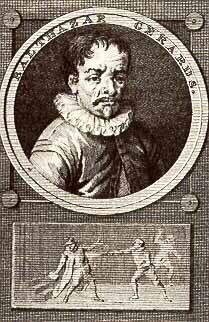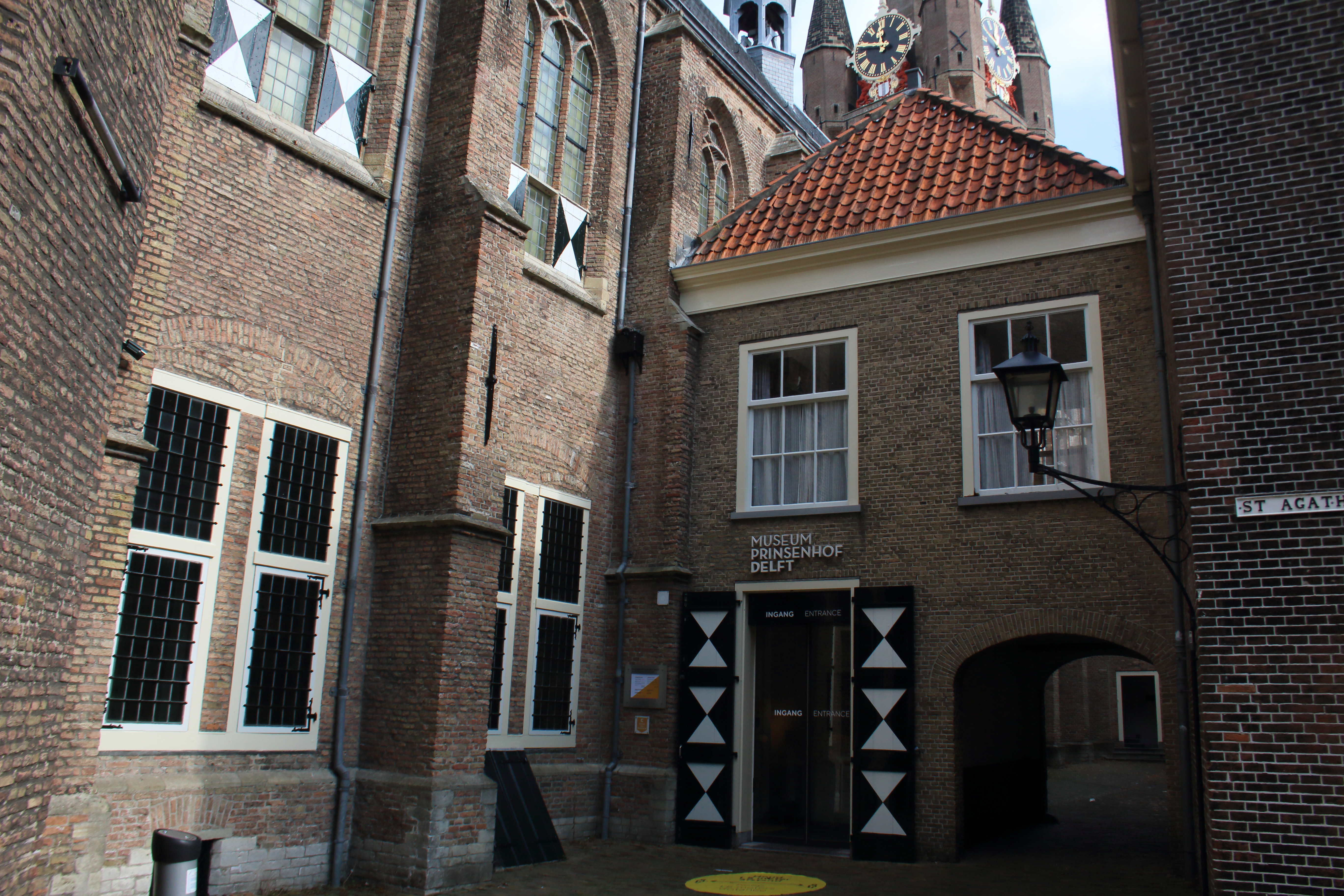|
Balthasar Gérard
Balthasar Gérard (alternative spellings Gerards or Gerardts; c. 1557 – 14 July 1584) was the assassin of the Dutch revolt's leader, William the Silent of the House of Orange (William the Silent, and later known as the "Father of the Fatherland"). He killed William the Silent in Delft on 10 July 1584, by shooting him twice with a pair of pistols, and was afterwards tried, convicted, tortured, and executed. Gérard was born in Franche-Comté (then belonging to Holy Roman Empire, afterwards to France). He came from a Roman Catholic family with 11 children and was a great admirer of Philip II, king of Spain and the Netherlands. He studied law at the University of Dole. On 15 March 1580, King Philip had offered a reward of 25,000 crowns, peerage and an inheritable estate to anyone who killed or captured William the Silent, to whom he referred in his decree as a "pest on the whole of Christianity and the enemy of the human race". Preparations After the reward offered by Philip w ... [...More Info...] [...Related Items...] OR: [Wikipedia] [Google] [Baidu] |
Stedelijk Museum Het Prinsenhof
The Prinsenhof ("The Court of the Prince") in the city of Delft in the Netherlands is an urban palace built in the Middle Ages as a monastery. Later it served as a residence for William the Silent. William was assassinated in the Prinsenhof by Balthasar Gérard in 1584 - the holes in the wall made by the bullets at the main stairs are still visible. Since 1911, the building houses a municipal museum. Today, the building displays a collection of Dutch Golden Age painting Dutch Golden Age painting is the painting of the Dutch Golden Age, a period in Dutch history roughly spanning the 17th century, during and after the later part of the Eighty Years' War (1568–1648) for Dutch independence. The new Dutch Republ ...s. Gallery KogelgatenPrinsenhof.jpg, Bullet holes from the assassination of William the Silent at the main stairs of the Prinsenhof Delft - Prinsenhof in the Netherlands.jpg, Former St. Agatha church Prinsenhof-2006 1.jpg, The garden of the Prinsenhof References ... [...More Info...] [...Related Items...] OR: [Wikipedia] [Google] [Baidu] |
Juan De Jáuregui (assassin)
Juan de Jáuregui (1562 – March 18, 1582) was killed trying to assassinate Prince William I of Orange. He was a Biscayan by his birth in Bilbao. In 1582, he was in the service of a Spanish fur merchant, Gaspar de Añastro from Vitoria, who resided at Antwerp. De Añastro had lost three ships and was tempted by the supposed reward of 80,000 ducats and the habit of the Order of Santiago offered by Philip II of Spain for the assassination of William the Silent, prince of Orange, and being himself without courage to undertake the task, De Añastro (with the help of his cashier Antonio de Venero, a 19-year-old also from Bilbao, and the Dominican friar Antonio Timmerman, from Dunkirk) persuaded his poor accounting assistant Jáuregui to attempt the murder for the sum of 2877 crowns. Jáuregui had been convinced not only that heaven would smile on his attempt, but that he would become invisible immediately afterwards, and thus escape easily. On Sunday, March 18, 1582, as the prince ... [...More Info...] [...Related Items...] OR: [Wikipedia] [Google] [Baidu] |
Wales
Wales ( cy, Cymru ) is a Countries of the United Kingdom, country that is part of the United Kingdom. It is bordered by England to the Wales–England border, east, the Irish Sea to the north and west, the Celtic Sea to the south west and the Bristol Channel to the south. It had a population in 2021 of 3,107,500 and has a total area of . Wales has over of coastline and is largely mountainous with its higher peaks in the north and central areas, including Snowdon (), its highest summit. The country lies within the Temperateness, north temperate zone and has a changeable, maritime climate. The capital and largest city is Cardiff. Welsh national identity emerged among the Celtic Britons after the Roman withdrawal from Britain in the 5th century, and Wales was formed as a Kingdom of Wales, kingdom under Gruffydd ap Llywelyn in 1055. Wales is regarded as one of the Celtic nations. The Conquest of Wales by Edward I, conquest of Wales by Edward I of England was completed by 1283, th ... [...More Info...] [...Related Items...] OR: [Wikipedia] [Google] [Baidu] |
Slug (projectile)
A slug is a term used for a bulky solid ballistic projectile. It is "solid" in the sense of being composed of one piece; the shape can vary widely, including partially hollowed shapes. The term is occasionally applied to bullets (just the projectile, never the cartridge as a whole), but is most commonly applied to one-piece shotgun slugs, to differentiate them from shotshells containing numerous shots. Slugs are commonly fired from choked smoothbore barrels, but some specially-designed slug barrels have riflings that can impart gyroscopic spin required for in-flight stability. An airgun slug is a new type of pellet recently developed for pre-charged pneumatic airguns. Unlike the conventional diabolo-shaped pellet, which is aerodynamically poor and relies heavily on drag-stabilisation to maintain accuracy, the slug pellet is cylindro-conoidally shaped like a Minié ball and relies predominantly on spin-stabilisation from a rifled barrel. Because of the greater contact area ... [...More Info...] [...Related Items...] OR: [Wikipedia] [Google] [Baidu] |
Halberd
A halberd (also called halbard, halbert or Swiss voulge) is a two-handed pole weapon that came to prominent use during the 13th, 14th, 15th, and 16th centuries. The word ''halberd'' is cognate with the German word ''Hellebarde'', deriving from Middle High German ''halm'' (handle) and ''barte'' (battleaxe) joined to form ''helmbarte''. Troops that used the weapon were called halberdiers. The halberd consists of an axe blade topped with a spike mounted on a long shaft. It always has a hook or thorn on the back side of the axe blade for grappling mounted combatants. It is very similar to certain forms of the voulge in design and usage. The halberd was usually 1.5 to 1.8 metres (5 to 6 feet) long. The word has also been used to describe a weapon of the Early Bronze Age in Western Europe. This consisted of a blade mounted on a pole at a right angle. History The halberd was inexpensive to produce and very versatile in battle. As the halberd was eventually refined, its point was mo ... [...More Info...] [...Related Items...] OR: [Wikipedia] [Google] [Baidu] |
Prinsenhof
The Prinsenhof ("The Court of the Prince") in the city of Delft in the Netherlands is an urban palace built in the Middle Ages as a monastery. Later it served as a residence for William the Silent. William was assassinated in the Prinsenhof by Balthasar Gérard in 1584 - the holes in the wall made by the bullets at the main stairs are still visible. Since 1911, the building houses a municipal museum. Today, the building displays a collection of Dutch Golden Age painting Dutch Golden Age painting is the painting of the Dutch Golden Age, a period in Dutch history roughly spanning the 17th century, during and after the later part of the Eighty Years' War (1568–1648) for Dutch independence. The new Dutch Republ ...s. Gallery KogelgatenPrinsenhof.jpg, Bullet holes from the assassination of William the Silent at the main stairs of the Prinsenhof Delft - Prinsenhof in the Netherlands.jpg, Former St. Agatha church Prinsenhof-2006 1.jpg, The garden of the Prinsenhof Reference ... [...More Info...] [...Related Items...] OR: [Wikipedia] [Google] [Baidu] |
Vassal
A vassal or liege subject is a person regarded as having a mutual obligation to a lord or monarch, in the context of the feudal system in medieval Europe. While the subordinate party is called a vassal, the dominant party is called a suzerain. While the rights and obligations of a vassal are called vassalage, and the rights and obligations of a suzerain are called suzerainty. The obligations of a vassal often included military support by knights in exchange for certain privileges, usually including land held as a tenant or fief. The term is also applied to similar arrangements in other feudal societies. In contrast, fealty (''fidelitas'') was sworn, unconditional loyalty to a monarch. European vassalage In fully developed vassalage, the lord and the vassal would take part in a commendation ceremony composed of two parts, the homage and the fealty, including the use of Christian sacraments to show its sacred importance. According to Eginhard's brief description, the ''commenda ... [...More Info...] [...Related Items...] OR: [Wikipedia] [Google] [Baidu] |
Abbey
An abbey is a type of monastery used by members of a religious order under the governance of an abbot or abbess. Abbeys provide a complex of buildings and land for religious activities, work, and housing of Christian monks and nuns. The concept of the abbey has developed over many centuries from the early monastic ways of religious men and women where they would live isolated from the lay community about them. Religious life in an abbey may be monastic. An abbey may be the home of an enclosed religious order or may be open to visitors. The layout of the church and associated buildings of an abbey often follows a set plan determined by the founding religious order. Abbeys are often self-sufficient while using any abundance of produce or skill to provide care to the poor and needy, refuge to the persecuted, or education to the young. Some abbeys offer accommodation to people who are seeking spiritual retreat. There are many famous abbeys across the Mediterranean Basin and Europe ... [...More Info...] [...Related Items...] OR: [Wikipedia] [Google] [Baidu] |
Franciscan
The Franciscans are a group of related Mendicant orders, mendicant Christianity, Christian Catholic religious order, religious orders within the Catholic Church. Founded in 1209 by Italian Catholic friar Francis of Assisi, these orders include three independent orders for men (the Order of Friars Minor being the largest contemporary male order), orders for women religious such as the Order of Saint Clare, and the Third Order of Saint Francis open to male and female members. They adhere to the teachings and spiritual disciplines of the founder and of his main associates and followers, such as Clare of Assisi, Anthony of Padua, and Elizabeth of Hungary. Several smaller Franciscan spirituality in Protestantism, Protestant Franciscan orders exist as well, notably in the Anglican and Lutheran traditions (e.g. the Community of Francis and Clare). Francis began preaching around 1207 and traveled to Rome to seek approval from Pope Innocent III in 1209 to form a new religious order. The o ... [...More Info...] [...Related Items...] OR: [Wikipedia] [Google] [Baidu] |
Tournai
Tournai or Tournay ( ; ; nl, Doornik ; pcd, Tornai; wa, Tornè ; la, Tornacum) is a city and municipality of Wallonia located in the province of Hainaut, Belgium. It lies southwest of Brussels on the river Scheldt. Tournai is part of Eurometropolis Lille–Kortrijk–Tournai, which had 2,155,161 residents in 2008. Tournai is one of the oldest cities in Belgium and has played an important role in the country's cultural history. It was the first capital of the Frankish Empire, with Clovis I being born here. Geography Tournai is located in the Picardy Wallonia and Romance Flanders region of Belgium, at the southern limit of the Flemish plain, in the basin of the River Scheldt (''Escaut'' in French, ''Schelde'' in Dutch). Administratively, the town is part of the Province of Hainaut, itself part of Wallonia. It is also a municipality that is part of the French-speaking Community of Belgium. Tournai has its own arrondissements, both administrative and judicial. Its area of ma ... [...More Info...] [...Related Items...] OR: [Wikipedia] [Google] [Baidu] |


.jpg)


